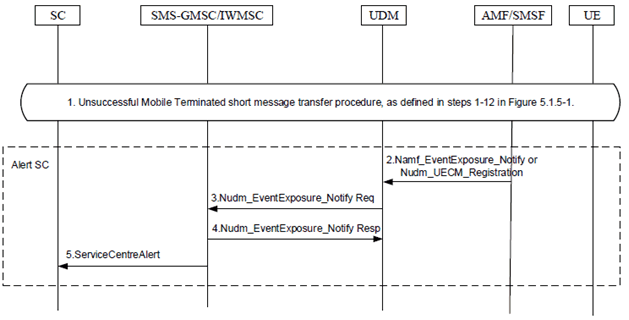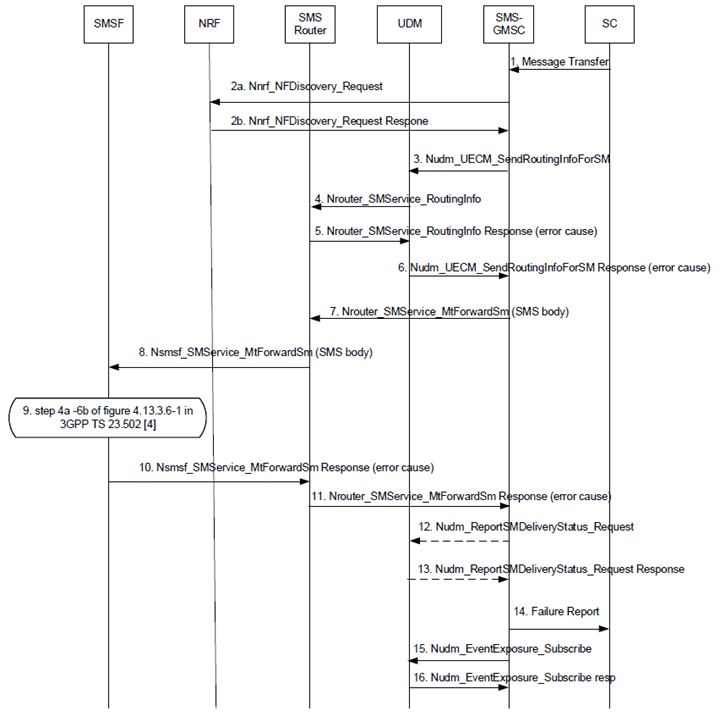Content for TS 23.540 Word version: 19.0.0
1…
4…
5…
5.1.3
5.1.4
5.1.5
5.1.6
5.1.7…
5.1.7.2.3…
5.1.7.3.2
5.1.7.3.3
5.1.7.3.4
5.1.7.3.5
5.1.7.4
5.1.8…
5.2…
6…
5.1.8 Alert p. 34
Figure 5.1.8-1 depicts procedure for alert.

Step 1.
Unsuccessful Mobile Terminated short message transfer (without IP-SM-GW/SMS Router) procedure, as defined in steps 1-10 in Figure 5.1.5-1.
Step 2.
UDM receives Namf_EventExposure_Notify or Nudm_UECM_Registration operation from AMF or SMSF indicating that the UE is reachable for SMS delivery; or UDM receives Nudm_UECM_Update operation from SMSF indicating that the UE has memory capacity available.
Step 3-4.
The UDM notifies the "UE_MEMORY_AVAILABLE_FOR_SMS" or "UE_REACHABILITY_FOR_SMS" event to the SMS-GMSC/IWMSC accordingly. The UDM updates the corresponding reachability flags and deletes the subscription to UE reachability for SMS event created by the SMS-GMSC.
Step 5.
ServiceCentrealert as defined in Operation 13 of Figure 20a in TS 23.040.
5.1.9 Unsuccessful Mobile Terminated short message transfer via SMS Router p. 35

Step 1.
MT SMS interaction between SC and SMS-GMSC follow the current procedure as defined in TS 23.040.
Step 2a.
SMS-GMSC invokes the Nnrf_NFDiscovery to discover and select the UDM instance(s), supporting SMS SBI interfaces, and managing the user subscriptions of the GPSI. The SMS-GMSC may need to retrieve the PLMN ID of the recipients GPSI before the discovery of the UDM instance based on the GPSI-to-Subscription-Network resolution procedure defined in clause 5.1.7.
Step 2b.
If no UDM supporting SMS SBI could be discovered, the NRF indicates so to SMS-GMSC (by not including any UDM instance in the discovery response), and SMS-GMSC shall quit the SBI-based procedure and fallback to legacy (MAP/Diameter) protocol based procedures, as defined in TS 23.040,
or if a UDM supporting SMS SBI is discovered and selected, NRF returns the IP addresses or FQDNs of the serving UDM to provide Nudm_UECM_SendRoutingInfoForSM service to SMS-GMSC.
Step 3.
SMS-GMSC invokes Nudm_UECM_SendRoutingInfoForSM (GPSI) to the UDM to get the serving node information for all access types for the UE.
Step 4.
The UDM shall check the registration/reachability flags to determine the potential target nodes, e.g. SMSF. For MT SM transfer via SMS Router, the UDM shall invoke the Nrouter_SMService_RoutingInfo to provide the SMSF Instance Id to the SMS Router. The address of the SMS Router to be contacted by the UDM may be configured locally.
Step 5.
If any failure at this step, the SMS Router shall send Nrouter_SMService_RoutingInfo response with error cause to the UDM.
Step 6.
If the UDM receives error response from SMS Router in step 5 or UDM is failed after step 3, e.g. user not found in the UDM, the UDM shall respond to the SMS-GMSC by sending Nudm_UECM_SendRoutingInfoForSM response with error cause. If there is no target node address registered in the UDM, a response with error case indicating absent subscriber for SM is sent to the SMS-GMSC and the procedure continues in step 15.
Step 7.
If successful response is returned in step 6, the SMS-GMSC forwards the SMS message to the SMS Router by invoking Nrouter_SMService_MtForwardSm service operation.
Step 8.
The SMS Router forwards the SMS message to the SMSF by invoking Nsmsf_SMService_MtForwardSm service operation.
Step 9.
MT SMS over NAS procedure between SMSF, AMF and UE is same as the definition in step 4a to 6b of Figure 4.13.3.6-1 of TS 23.502.
Step 10.
If the AMF informs the SMSF that it cannot deliver the MT-SMS to the UE in step 9, e.g. UE is not reachable, or the SMSF is failed at this step, e.g. memory capacity exceeded, the SMSF shall send the Nsmsf_SMService_MtForwardSm response with error cause to the SMS Router.
Step 11.
If the SMS Router receives error response from SMSF in step 10 or the SMS Router is failed after step 7, the SMS Router shall send the Nrouter_SMService_MtForwardSm response with error cause to the SMS-GMSC.
Step 12-13.
The SMS-GMSC may report the SM-Delivery Status (e.g. UE is not reachable or memory capacity exceeded) to UDM by invoking Nudm_ReportSMDeliveryStatus_Request .
Step 14.
If the SMS-GMSC receives error response from SMS Router in step 6 or step 11, the SMS-GMSC sends the failure report to SC as defined in TS 23.040.
Step 15.
The SMS-GMSC subscribes in UDM to be notified when the UE becomes reachable for SMS (i.e. when the UE gets in radio contact with the AMF while an SMSF is actually registered, or when an SMSF gets registered) by using the Nudm_EventExposure_Subscribe service operation for Reachability for SMS event as defined in TS 23.502.
Step 16.
If applicable, the UDM subscribes to UE reachability notification in the AMF(s) using the Namf_EventExposure service and sets the relevant reachability flags. The UDM acknowledges the event subscription created by the SMS-GMSC.